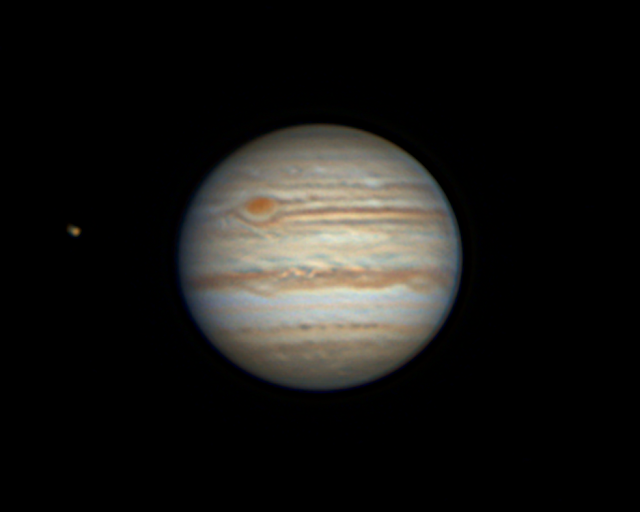 |
| 18:46:53 |
 |
| 19:01:44 |
 |
| 19:11:39 |
 |
| 19:24:27 |
 |
| 19:37:17 |
 |
| 19:51:50 |
 |
| 20:12:01 |
 |
| 20:23:13 |
 |
| 20:35:37 |
 |
| 20:51:08 |
 |
| 21:07:18 |
 |
| 20:20:14 |
 |
| 21:34:58 |
 |
| 18:46:53 |
 |
| 19:01:44 |
 |
| 19:11:39 |
 |
| 19:24:27 |
 |
| 19:37:17 |
 |
| 19:51:50 |
 |
| 20:12:01 |
 |
| 20:23:13 |
 |
| 20:35:37 |
 |
| 20:51:08 |
 |
| 21:07:18 |
 |
| 20:20:14 |
 |
| 21:34:58 |
The goals for the two nights were to image Galilean satellite and satellite shadow transits. In the past I would magnify planets with a 2x Barlow but have decide to eschew Barlow in favor of prime focus with shorter exposures and higher frame rate. The planetary critical planetary sampling formula yields a focal length of 2349 mm a bit longer than my Celestron 8's 2030 mm. Considering typical mid Atlantic seeing prime focus is good enough. What follow are images of Jupiter acquired over 90 minutes and 2 hours on the two dates. Unfortunately, on the 8th Jupiter was just beginning to slide behind a nearby tree as the shadow transits took place.
11/8/2022.
 |
| 19:32:08 |
 |
| 19:35:43 |
 |
| 19:54:21 |
 |
| 20:04:46 |
 |
| 20:19:58 |
 |
| 20:29:23 |
 |
| 20:42:28 |
 |
| 20:52:40 |
 |
| 21:07:20 |
 |
| 21:20:45 |
 |
| 21:33:20 |
 |
| 21:44:56 |
 |
| 21:59:01 |
Lunar terrain imaged around 11/3/2022 during gibbous moon. Setup: Celestro 8/AVX,ASI178MC. Gain: 200 Exposure: 4.097 ms, Frame count: 5000, Format: 1024x768, SER, Raw16. Post Processing: Stack averaged via Autostackkert!3, color correction and wavelet sharpening in Paintshop Pro 2021.
 |
| Copernicus |
 |
| Goldschmidt |
 |
| Mercator, Campanus, Kies, Bullialdus |
 |
| Montes Recti |
 |
| Montes_Riphaeus, Lansberg, Reinhold |
 |
| Plato |
 |
| Plato |